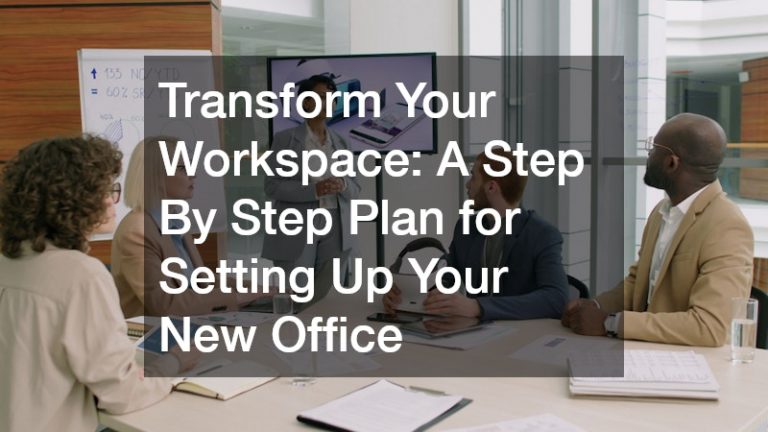Setting up a new office is an exciting opportunity to reimagine how your business functions, communicates, and thrives. Whether you’re moving into your first space or relocating to something that better suits your goals, the process comes with countless decisions. From legal logistics and insurance to physical layout and professional services, getting it right from the start lays a solid foundation for long-term success. Building a step by step plan for each phase not only prevents costly mistakes but also gives you peace of mind knowing every corner of your office, both physical and operational, has been thoughtfully considered.
With so many moving parts, the key to success is having a structured timeline. Instead of tackling everything at once, it’s smarter to follow a sequence that aligns with practical setup needs. You’ll want to begin with foundational elements, like securing legal protections and making sure your business is properly covered. From there, your focus can shift to branding, infrastructure, and support systems. Eventually, you’ll dive into financial management, internal operations, and team-building. Each of these pieces plays a vital role in turning a blank space into a functioning, productive, and thriving workplace.
What follows is a breakdown of essential tasks involved in setting up your workspace, guided by a logical, phased approach. Each step serves a distinct purpose in turning your vision into a reality. With the right mindset and a clearly defined plan, you can transform your workspace into a launchpad for growth and success. Use this article as your comprehensive roadmap—your step-by-step plan to building an office that works as hard as you do.
1. Start with Legal Help

Before any physical changes take place, the most important task in launching a new office is ensuring your legal groundwork is solid. It’s easy to get caught up in desks, paint colors, and tech setups, but overlooking legal considerations can cost you far more in the long run. This phase should include reviewing your business structure, understanding regulatory requirements, and checking for potential liabilities related to your new location or operations. This is where careful planning pays off.
To navigate this terrain, it’s best to consult with a qualified professional who specializes in business law. An experienced attorney can help you with everything from contract reviews to lease negotiations and intellectual property concerns. They’ll also ensure your business complies with all relevant local, state, and federal laws. This expert oversight minimizes risk and makes sure that, from the very start, your company is legally protected.
By including legal review early in your step by step plan, you not only prevent future problems, but you also make room for smooth, confident growth. With a strong legal foundation, you’re free to focus on more creative and strategic parts of your business. This peace of mind gives your setup momentum and ensures nothing slows you down once operations are underway.
2. Protect Your Business
Once you’ve established legal clarity, the next critical piece of your new office setup is making sure your investment is protected. A new workspace means new risks—property damage, employee injuries, or even business interruptions. Without the proper safety net, one unexpected incident can derail months of hard work. That’s why it’s essential to review your coverage needs early.
Working with a trusted business insurance agency gives you access to tailored policies that match the unique aspects of your office and industry. These providers assess the full scope of your needs, including liability, property, cyber protection, and employee coverage. Getting the right mix from the beginning saves time and shields you from costly surprises later.
Including insurance in your step by step plan brings both practical and financial security. It’s about creating a working environment where you and your employees can thrive without constantly worrying about “what-ifs.” With risk mitigation in place, you’ve checked off one of the most vital components of responsible office planning.
3. Plan Exterior Branding

After securing internal protections, it’s time to think about how your new office will look to the outside world. First impressions matter, and your visual branding—especially the signage—serves as both a marketing tool and a statement of professionalism. From your storefront or building entrance to interior wayfinding, the design and placement of visual cues influence how people perceive your business.
Selecting and installing business signs involves more than just choosing a logo and slapping it on the wall. You’ll need to consider local regulations, visibility, accessibility, and brand consistency. Good signage blends functionality and creativity, guiding visitors while reinforcing your identity. This part of your setup plays a major role in drawing in new customers and helping them navigate your space.
When included in your step by step plan, visual branding gives your space personality and polish. It turns your office from just another unit into a branded experience. Taking the time to get signage right means you’re not just setting up an office—you’re building recognition and trust from the moment people walk by or through the door.
4. Furnish with Purpose
Once legal and branding matters are handled, it’s time to start shaping the interior of your new space. Choosing the right furniture does more than fill the room—it sets the tone for how your team will work, move, and collaborate. Functional design improves productivity, enhances comfort, and supports workflow, while poor design creates unnecessary obstacles. This step is where visual appeal meets practical planning.
One of the most effective ways to streamline this process is to work with professionals who specialize in office furniture install services. These experts don’t just deliver desks and chairs—they help assess layout, spacing, and ergonomics to ensure everything fits your team’s unique needs. Proper installation also guarantees safety and efficiency, helping you avoid structural mistakes or uncomfortable setups that hinder performance.
When included in your step by step plan, furnishing becomes less of a chore and more of a design strategy. A well-furnished office supports employee well-being and contributes to an organized, welcoming atmosphere. Investing in quality furnishings at the right time reinforces your company culture and sets the stage for daily success.
5. Install Tech Systems

After your office is physically structured, the next step is making sure it functions digitally. Technology is the backbone of modern business, and a workspace without it is essentially non-operational. From internet access to communication tools, internal systems, and security software, tech integration is crucial for smooth operations and long-term scalability.
Working with a reliable computer IT service ensures that everything from your servers to your printers is installed and secured properly. These professionals can help set up networking systems, manage cybersecurity protocols, and ensure data backup practices are in place. Their role is essential, especially if your team handles sensitive data or relies heavily on cloud-based tools for collaboration.
Incorporating tech setup into your step by step plan prevents operational delays and gives your team the tools they need to work confidently from day one. Rather than fixing tech issues after they arise, you’re building a foundation that supports seamless productivity and secure digital infrastructure from the start.
6. Prep for Clean Space
With furniture and tech in place, your office may look ready, but it’s not truly usable until it’s clean, hygienic, and welcoming. A fresh workspace boosts morale and provides a healthy environment for your team and guests alike. Cleanliness isn’t just about appearances—it directly impacts productivity and well-being.
Hiring a dependable office cleaning service ensures your space is not only spotless but also maintained on a consistent schedule. These professionals handle everything from floor care to sanitation, helping you meet workplace standards and minimize distractions caused by clutter or mess. They’re especially important in high-traffic or shared environments where hygiene must be a priority.
By integrating cleaning support into your step by step plan, you make cleanliness a core part of your office culture. Rather than reacting to messes, you’re proactively creating an environment where everyone can focus, collaborate, and enjoy being at work. It’s a small step that has a big impact on overall operations and employee satisfaction.
7. Secure Confidential Data

In any professional office setting, dealing with sensitive information is inevitable. Whether it’s employee records, client contracts, or internal reports, paper documents often accumulate quickly. While digital security is critical, properly disposing of physical documents is just as important in preventing breaches and maintaining compliance.
That’s where a reliable shredding service comes in. These services ensure that all sensitive paperwork is destroyed in a secure and legally compliant manner. Rather than relying on basic in-office shredders that can malfunction or leave data legible, professional services handle document disposal at scale and with full accountability.
Incorporating a secure disposal process into your step by step plan helps you build a culture of responsibility and privacy from the beginning. It’s a forward-thinking move that protects your business, instills client trust, and keeps your operations organized and compliant as you grow.
8. Set Up Financial Systems
Once your office is physically and digitally functional, it’s time to focus on financial systems. A well-managed budget and clear tracking of income and expenses are essential to sustainable growth. Whether you’re managing payroll, paying bills, or tracking revenue, accuracy and transparency matter.
Engaging with professional bookkeeping services ensures your records are maintained correctly from day one. These experts organize financial data, monitor cash flow, and prepare reports that inform smarter business decisions. Having this support in place helps you stay compliant with tax regulations and avoid costly mistakes down the road.
Building bookkeeping into your step by step plan prevents confusion and allows you to scale with confidence. Instead of playing catch-up with financials, you’re positioned to grow strategically and take advantage of opportunities without worrying about administrative gaps.
9. Prepare for Growth
As your team begins to take shape, managing compensation becomes one of the most important operational priorities. Employees need to be paid accurately and on time, and you need a system that keeps records organized and ensures tax compliance. A smooth payroll process builds trust and stability across your organization.
Working with a reputable payroll service can streamline everything from wage calculation to direct deposits and end-of-year reporting. These services also help you stay up to date with employment laws and handle deductions and benefits accurately. As your team grows, the complexity of payroll increases, making professional support essential.
By incorporating payroll into your step by step plan, you’re laying the groundwork for long-term success. Reliable compensation management isn’t just about logistics—it’s a commitment to your people. When employees feel secure about their pay, they’re more likely to stay engaged, productive, and loyal to your mission.
10. Expand Connections
The final step in establishing your new office is looking outward. No business thrives in isolation—success often comes down to the relationships you build and the communities you engage with. From partnerships to peer support, expanding your professional circle brings new perspectives and growth opportunities.
Efforts to grow your networks can include joining local business groups, attending industry events, or even hosting gatherings in your newly established office. These connections offer valuable insights, potential collaborations, and access to services or clients you may not reach otherwise.
When you embed networking into your step by step plan, you’re not just opening an office. You’re launching your business into a thriving ecosystem. Networking ensures that your workspace becomes more than a place to work—it becomes a hub for opportunity, innovation, and long-term momentum.
Building a Strong Foundation for Your Office
Setting up a new office is about more than just finding a space and filling it with desks—it’s a thoughtful, strategic process that sets the foundation for how your business operates and grows. From choosing your legal support and securing insurance to handling branding, furnishings, technology, cleanliness, and compliance, each piece plays a crucial role in creating a workplace that functions smoothly and supports your vision.
When you follow a detailed plan like this, you aren’t just reacting to immediate needs—you’re creating a proactive roadmap that supports both your short-term setup and your long-term success. It allows you to delegate with confidence, build your team on solid ground, and operate in a space that’s tailored to your goals and responsibilities. Each decision contributes to the culture, functionality, and potential of your business.
Whether you’re opening your first location or relocating an existing one, this guide is designed to keep the process smooth, professional, and future-focused. With careful planning and the right support partners in place, your new office will become more than just a place to work—it will become a reflection of your brand, your values, and your commitment to growth. Use this comprehensive framework to transform your workspace with purpose and precision.




